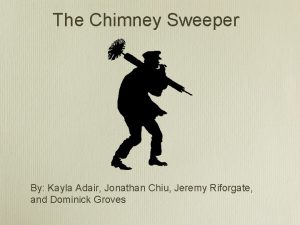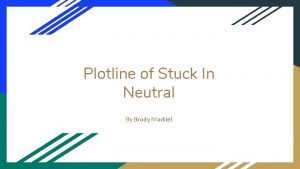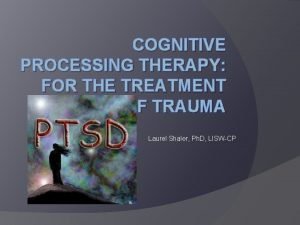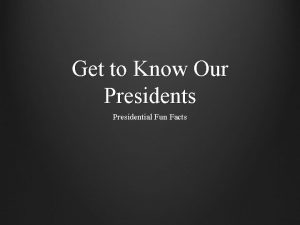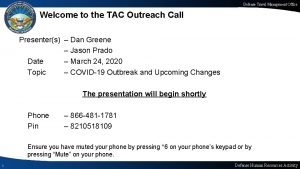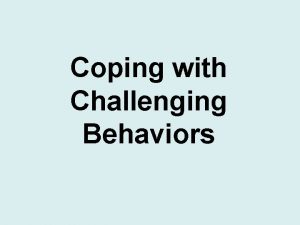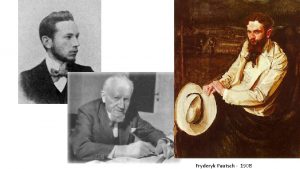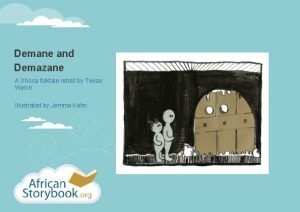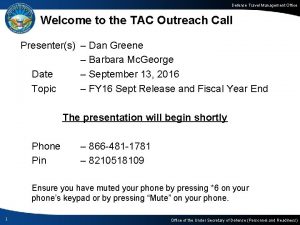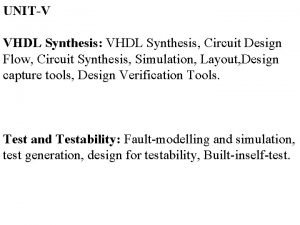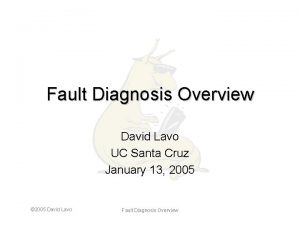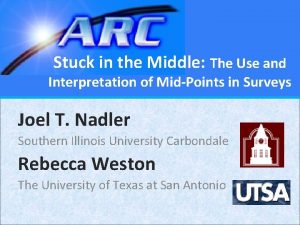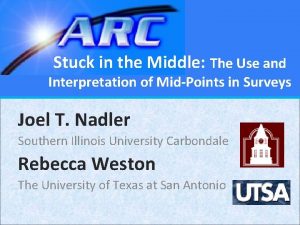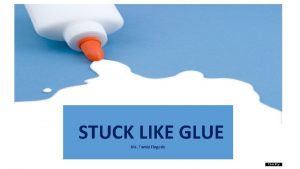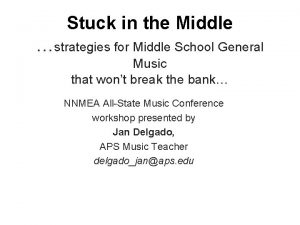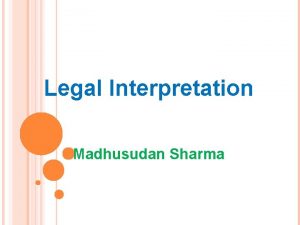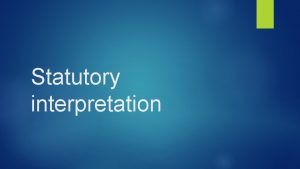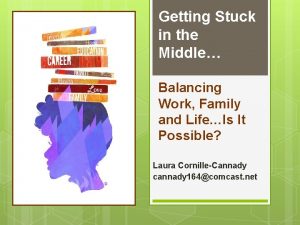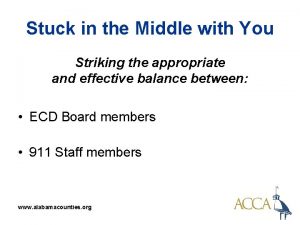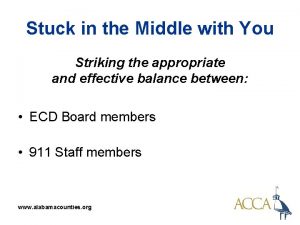Stuck in the Middle The Use and Interpretation














- Slides: 14

Stuck in the Middle: The Use and Interpretation of Mid-Points in Surveys Joel T. Nadler Southern Illinois University Carbondale Rebecca Weston The University of Texas at San Antonio

Likert type Attitudinal Scales Ø Likert type scales Ø Four to seven response options (Dillman, 2000). Ø Balanced Ø Standard (1= Strongly Disagree, 2= Disagree, 3= Neither, 4= Agree, to 5=Strongly Agree)

Odd or Even? Ø Mid-points in Likert type scales (Fowler, 2008). Ø Even numbered ØForce a choice ØMiddle choice may be a refuge (Schuman & Presser) Ø Odd numbered ØAllowing neutrality

Methods: Survey Ø 28 Questions ØIssues and their political importance To which political party are the following issues more important? 1. Abortion Rights (Very Republican – Very Democrat) 2. Economy (Very Republican – Very Democrat) ØLikelihood of voting for candidates How likely are you to vote for a person belonging to one of the following groups, regardless of their political party affiliation? 13. African American (Very Unlikely – Very Likely) 14. Asian American (Very Unlikely – Very Likely) ØVoting tendencies 25. I am politically active. (Strongly Disagree – Strongly Agree)

Methods: Manipulation Ø 4 point scale (forced choice) Strongly Disagree Agree Strongly Agree Neither Agree Strongly Agree No Opinion Ø 5 point scale “Neither” Strongly Disagree Ø 4 point scale “No Opinion” Strongly Disagree Agree Ø All three scales were coded using the same 5 point scale.

Method: Participants Ø College students at a mid-west state university Ø Data collected during the 2008 presidential election Ø N = 249 Ø Age M = 22, SD = 5 Ø 133 men, 112 women Ø 46 Republicans, 116 Democrats, 31 Independent, 11 Other

Results Ø MANOVA Response Mode on Mean responses Ø Results indicate 50% of the 28 item’s means significantly differed dependent on response options, Wilks Lambda =. 59, F(56, 424) = 2. 30, p =. 001 Ø The 4 point scale with “No Opinion” resulted in the highest means and the 5 point scale the lowest means.

Question 5 Point Scale 4 Point Scale No Opinion 3. 11* 3. 62 2. 46* 2. 80 3. 01 Q 7. Gun Control 3. 21* 2. 81* 3. 59 Q 9. Immigration 3. 43* 3. 14* 3. 96 Q 12. Taxes 2. 93* 3. 22 3. 49 Q 13. African American (1 Unlikely – 5 Likely) 3. 68* 3. 72* 4. 33 Q 14. Asian American 3. 15* 3. 28* 3. 56 Q 16. Arab American 2. 44* 2. 86 2. 96 Q 17. Women 3. 32* 3. 63* 3. 96 Q 18. Men 4. 28* 4. 09* 4. 53 Q 21. Under 40 3. 44* 3. 59* 3. 89 Q 24. Extensive Experience 4. 14* 4. 15* 4. 48 Q 25. I am Politically Active (1 Disagree – 5 Agree) 2. 43* 2. 73* 3. 07 Q 27. Personal characteristics effect voting 3. 35* 3. 48 3. 56 Q 4. Foreign Trade (1 Democrat – 5 Republican) Q 5. Gay Marriage 4 Point Scale 3. 50 Results * Significantly different from “ 4 Point Scale No Opinion”

Results Ø Differences in the use of “Neither” compared to “No Opinion” were examined using a series of Chi-square tests Ø “Neither” was significantly chosen more often than “No Opinion” on 80% of the items.

Qualitative Results Ø When asked a question regarding the scale below how do you interpret the middle response? Strongly Disagree Neither Agree Strongly Agree Interpretation of “Neither” N Percentage Do not know, unsure, or do not care 48 19% No Opinion 46 19% Neither or Neutral 39 16% Both equal parts of agree and disagree 29 12% Undecided 22 9% Not applicable or confusing 19 9% Unwilling to answer 5 2% Disagree 5 2%

Discussion Ø This study adds to Schuman & Presser’s (1996) work on the use of mid points and “No Opinion” options in survey research. Ø Response option effect outcomes Ø Participants interpretation of “Neither” vary Ø Response bias

Discussion Ø Validity of Likert type scales. Ø The 4 point “No Opinion” scale resulted in higher scores compared to other scales Ø This study suggest a four point scale with “No Opinion” may provide the best of both worlds. ØPossible increase in the likelihood of detecting group differences ØEven Number of responses provide forced choice ØStill allowing participants to report no opinion

Discussion Ø The more often use of “Neither” compared to “No Opinion” and the variety of interpretations of neither offered by participants suggest that “Neither” may be over used and miss used by participants. Ø “No Opinion” and “Neither” seem to be measuring different attitudes.

References Ø Dillman, D. A. (2007). Mail and Internet Surveys. Hoboken, NJ: John Wiley & Sons. Ø Fowler, F. J. (2009). Survey Research Methods. Thousand Oaks, CA: Sage. Ø Schuman, H. & Presser, S. (1996). Questions & Answers in Attitude Surveys. Thousand Oaks, CA: Sage.
 How does interpretation b differ from interpretation a
How does interpretation b differ from interpretation a Chimney sweep stuck
Chimney sweep stuck Cindy mcdaniel stuck in neutral
Cindy mcdaniel stuck in neutral Trust star worksheet cpt
Trust star worksheet cpt Stuck past participle
Stuck past participle Presidential fun facts
Presidential fun facts Defense travel management office
Defense travel management office It takes two stuck in slide
It takes two stuck in slide Franz von stuck lucyfer
Franz von stuck lucyfer Melesala khan
Melesala khan Posack obligation
Posack obligation Stuck
Stuck Vhdl design flow
Vhdl design flow How long do periods last for dogs
How long do periods last for dogs Stuck at fault
Stuck at fault

